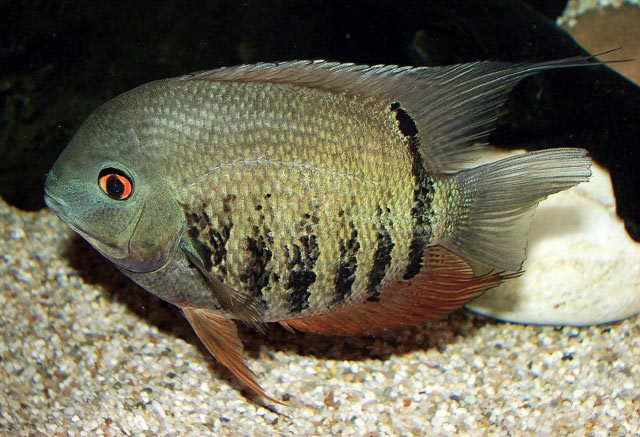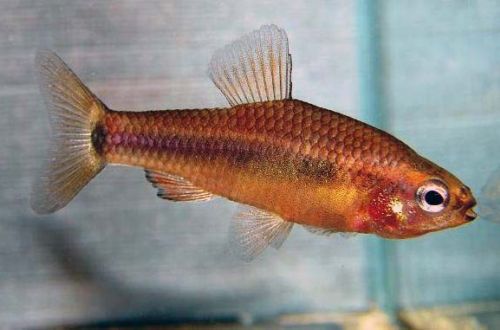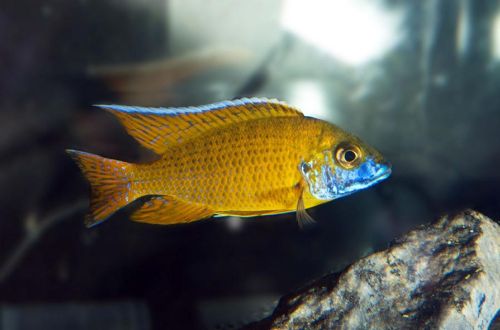
Severum Efasciatus
Cichlazoma Severum Efasciatus, scientific name Heros efasciatus, belongs to the Cichlidae family. One of the most popular South American cichlids, along with Discus, it is distinguished by its friendly disposition, beautiful coloration and unpretentiousness in content. Often it is sold at a young age and not all lovers understand that the fish grows to a respectable size, which can cause problems.

Contents
Habitat
It is widely distributed throughout the Amazon River basin (South America), found both in large rivers and smaller tributaries, in floodplain lakes. Prefers to stay close to the shore among the flooded roots and branches of trees.
Brief information:
- The volume of the aquarium – from 250 liters.
- Temperature – 22-29°C
- Value pH — 5.5–7.0
- Water hardness – soft (1-8 dGH)
- Substrate type – sandy
- Lighting – subdued
- Brackish water – no
- Water movement – light or moderate
- The size of the fish is 20–25 cm.
- Meals – any
- Temperament – peaceful
- Keeping in a group of 3-4 individuals
Description

In the wild, adults Severum reach a length of up to 30 cm. In the aquarium, they are noticeably smaller and rarely exceed 25 cm. The fish has a high oval body flattened laterally, somewhat resembling a disk. The coloration is blue or bluish-gray; in males, a red pigment appears behind the head. The dorsal and anal fins stretch from head to tail, in males they are more elongated and colored reddish.
Food
An omnivorous and unassuming species. Accepts all types of quality dry food (tablets, flakes, granules) as well as live, frozen and fresh herbal supplements such as earthworms, mussels, shrimp, bloodworms, blanched peas, spinach, spirulina flakes.
Maintenance and care, arrangement of the aquarium
The recommended volume of the tank for one pair of fish starts from 250 liters. The design is simple, it uses a sandy substrate, a few snags, twisted roots and other shelters. Plants are not a feature of the natural habitat, so it is not necessary to place them. The lighting is subdued.
In nature, rivers, lakes and other reservoirs of the Amazon are usually littered with numerous plant remains (fallen leaves, branches, fruits, etc.), which is why the water acquires a brownish tint with an abundance of dissolved tannins. In the aquarium, if desired, you can also recreate a similar brown aquatic environment. For this, dried tree leaves are used, which are pre-soaked until they sink, and then placed on the bottom. Either essences of tannins or leaves and bark of Indian almonds are purchased. Leaves are renewed every two weeks.
Maintenance of the aquarium consists in maintaining optimal water conditions, regular cleaning of the soil and weekly replacement of part of the water (10–15% of the volume) with fresh water.
Behavior and Compatibility
With the exception of spawning periods, Cichlazoma Severum Efasciatus behaves very calmly and friendly towards relatives and other species. Compatible with most fish capable of living in similar conditions, it goes well with its close relative Cichlazoma Severum Notatus. It is recommended to keep in a small group, if the fish is alone for a long time or grew up in a separate aquarium, then when neighbors appear, aggression is possible.
Breeding / breeding
Fish form pairs, while being quite picky about the choice of a partner, and not every male and female can give birth. Chances will increase if you get young cichlazoms that will grow together and naturally form at least one pair.
This species, like many other cichlids, is distinguished by caring for offspring. Eggs are deposited on any flat surface and fertilized, then the parents jointly protect the clutch from encroachment. The fry that have appeared also do not go unnoticed and continue to be near one of the parents, and in case of danger they take refuge in his mouth – this is an original evolutionary developed defense mechanism.
Fish diseases
The main cause of most diseases is unsuitable living conditions and poor-quality food. If the first symptoms are detected, you should check the water parameters and the presence of high concentrations of hazardous substances (ammonia, nitrites, nitrates, etc.), if necessary, bring the indicators back to normal and only then proceed with treatment. Read more about symptoms and treatments in the Aquarium Fish Diseases section.





